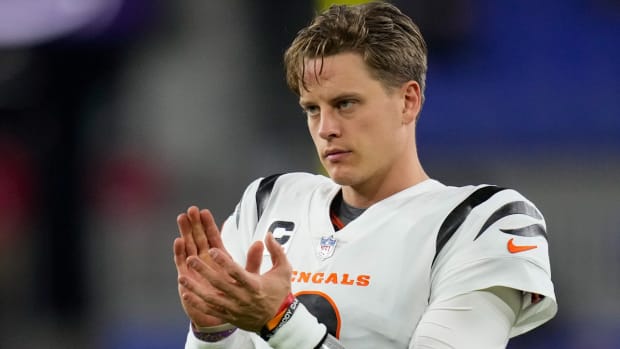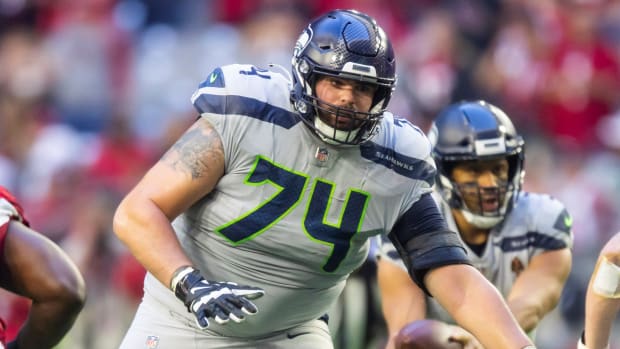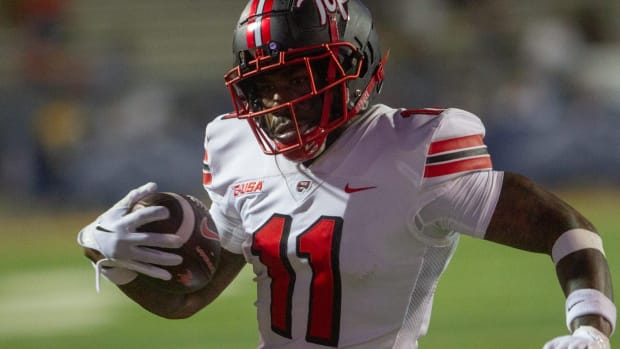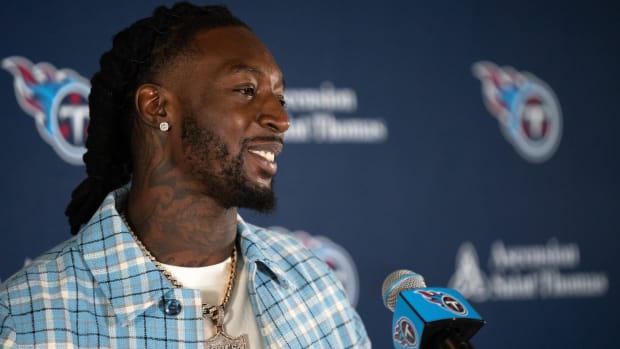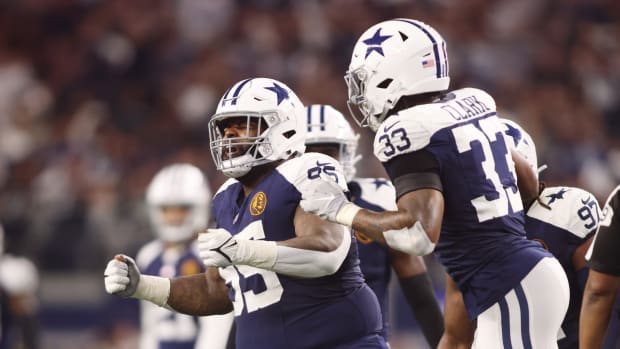Seattle Seahawks Analysis: Examining Laken Tomlinson's Fit on Offensive Line
Coming off a tough year in New York, the Seattle Seahawks will be hoping a change of scenery in a better scheme fit will help Laken Tomlinson return to his prior Pro Bowl form.
Since the start of the new league year in March, Seattle Seahawks general manager John Schneider has preached patience for those questioning the lack of moves made along the offensive line, indicating the franchise wasn't done exploring potential additions.
Out of the gate in free agency, the Seahawks lost four-year starting guard Damien Lewis to the Panthers after he signed a massive multi-year contract. A few days later, former starting center Evan Brown departed to join the Cardinals, while another former starter in guard Phil Haynes still remains unsigned without a new team. Before the calendar flipped to April, Schneider had only signed veterans Nick Harris and Tremayne Anchrum to one-year deals as depth pieces, which created the angst from the fan base.
But while Schneider didn't facilitate any of the splashy signings some fans may have desired to upgrade the unit up front, his words have rung true, as Seattle has indeed continued to bring in reinforcements, including striking a one-year deal with veteran guard Laken Tomlinson on Monday. The 32-year old most recently spent the past two seasons with the New York Jets before being waived in February as a cap casualty.

While his last season in New York didn't go as planned, Laken Tomlinson has a long track record of being a steady starter at left guard in the NFL.
Eric Hartline-USA TODAY Sports
On the surface, signing Tomlinson off the free agent scrap heap in mid-April may not be a move that inspires much confidence beyond his experience, especially considering his immense struggles with the Jets last season. Per Pro Football Focus, he allowed the second-most quarterback pressures (51) and fourth-most sacks (seven) among qualified guards last season and finished 51st in pass blocking efficiency rate (95.8), posting ugly numbers that suggest his best days may be behind him.
But in Tomlinson's defense, New York's entire offense unraveled after quarterback Aaron Rodgers tore his Achilles in the season opener and the former first-round pick out of Duke was far from the only player in the trenches negatively impacted. With backup quarterback Zach Wilson holding onto the football too long far too often, left tackle Mekhi Becton yielded 50 pressures and a whopping 12 sacks, while center Joe Tippman gave up 20 pressures and three sacks for a line that didn't stand a chance from the get go.
Just two years ago, the 6-3, 323-pound Tomlinson played far better football for the same team with many of the same players around him, giving up just one sack and 31 pressures. Prior to going to New York, he had four consecutive seasons in San Francisco with a 97.0 or better pass blocking efficiency rate and earned his first and only Pro Bowl spot in 2021, excelling for a perennial contender after two ho-hum seasons to begin his career in Detroit.
Looking for him to bounce back with the Seahawks after being discarded by the Jets, new offensive coordinator Ryan Grubb and line coach Scott Huff should look no further than Tomlinson's strong tenure with the 49ers if they hope to coax a rebound season from the nine-year veteran.
Though Tomlinson has the size and power to create push as a drive blocker, his previous track record suggests his zone blocking ability will be his greatest asset to Seattle's run game. In 2020, per PFF, he ranked second out of 46 qualified guards in zone blocking grade (86.6) in coach Kyle Shanahan's system, helping open run lanes for Jeff Wilson and Raheem Mostert. He was nearly as effective in 2021, finishing seventh in zone blocking grade (83.9) as San Francisco ended the year with the seventh-best rushing attack in the NFL.
In his first three seasons with the 49ers, he never finished lower than 23rd in zone blocking grade and gradually improved by year, developing into a top-10 caliber guard.
Historically, assuming he can round back into top form with a change of scenery, these grades suggest Tomlinson could be a quality fit for Grubb's scheme in the short term. Before pivoting to a more gap-centric attack in his final season at Washington in 2023, his teams ran zone at least 65 percent of the time in his previous five seasons as a college offensive coordinator, including four seasons at Fresno State.
Even as a pass protector, Tomlinson offered far greater consistency keeping Jimmy Garoppolo upright during his time in the bay area. In four of his five seasons with San Francisco, he scored a 67.2 or better pass blocking grade and in addition, he had three years allowing just three sacks on over 600 pass protection snaps.
Though he isn't in the prime of his career at this point, prior to signing Tomlinson, Seattle had only one guard on the roster with more than one game of NFL starting experience in Anthony Bradford, who started 10 games as a rookie last season. With that fact alone, even with the team likely to invest at least one draft choice at the position later this month, his presence as a mentor for a very young offensive line will be a godsend.
At bare minimum, Tomlinson should give the Seahawks a viable starting alternative who can compete against another veteran or an incoming rookie to succeed Lewis on the left side. And, whether he ultimately starts in the season opener in September or not, his arrival provides a bit of a glimpse into what Grubb's scheme will likely look like from a run game standpoint as he makes the jump to the NFL as a play caller.

